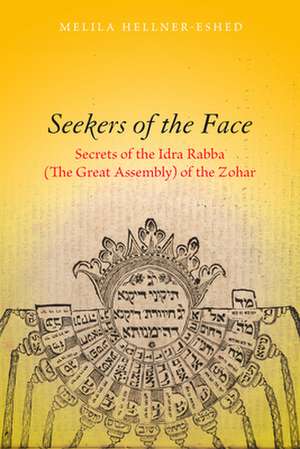Seekers of the Face – Secrets of the Idra Rabba (The Great Assembly) of the Zohar: Stanford Studies in Jewish Mysticism
Autor Melila Hellner–esheden Limba Engleză Hardback – 13 sep 2021
Seekers of the Face opens the profound treasure house at the heart of Judaism's most important mystical work: the Idra Rabba (Great Gathering) of the Zohar. This is the story of the Great Assembly of mystics called to order by the master teacher and hero of the Zohar, Rabbi Shim'on bar Yochai, to align the divine faces and to heal Jewish religion. The Idra Rabba demands a radical expansion of the religious worldview, as it reveals God's faces and bodies in daring, anthropomorphic language.
For the first time, Melila Hellner-Eshed makes this challenging, esoteric masterpiece meaningful for everyday readers. Hellner-Eshed expertly unpacks the Idra Rabba's rich grounding in tradition, its probing of hidden layers of consciousness and the psyche, and its striking, sacred images of the divine face. Leading readers of the Zohar on a transformative adventure in mystical experience, Seekers of the Face allows us to hear anew the Idra Rabba's bold call to heal and align the living faces of God.
Preț: 514.93 lei
Preț vechi: 635.71 lei
-19% Nou
98.54€ • 107.00$ • 82.78£
Carte tipărită la comandă
Livrare economică 22 aprilie-06 mai
Specificații
ISBN-10: 1503628426
Pagini: 480
Dimensiuni: 161 x 236 x 38 mm
Greutate: 0.82 kg
Editura: MK – Stanford University Press
Seria Stanford Studies in Jewish Mysticism
Cuprins
What is the Idra Rabba? This chapter covers the place of the Idra Rabba in zoharic literature as well as its reception, history, and scholarship.
This chapter follows the history of the language of the face of God from the Bible to midrashic and liturgical sources, as well as in psychoanalysis and philosophy.
This chapter discusses "the gaze" as healing, in mother-child relationships and in the divine faces. We also look at the restorative power of bathing in the light of God's face.
This chapter looks at Ze'eir Anpin as the God of Judgment, dual consciousness, Ze'eir Anpin and Gnosis, the dynamic between splitting and healing, and the importance of praying for the life of Ze'eir Anpin.
This chapter covers the secrets of the Godhead and also narrative, simultaneity, paradoxical language, the idraic midrash, space, time, consciousness, experience, the personality of the teacher and the role of the circle of disciples, as well as religious practice in the Idra.
This chapter explores four overarching themes that connect the whole Idra Rabba: the mythic account of the emergence of many faces of the Divine; the unfolding of existence; various ways of attenuating the power of Judgment (Din); reading through the lens of consciousness, Oneness, and the dual male and female.
This chapter lays out the Zohar as a manifesto calling for the healing of the face of Jewish religion.
The chapter is a close reading of the account of the opening of the Great Gathering.
This chapter explores the myth of the kings of Edom from the Bible to the Zohar, its place in the Zohar, and its first appearance in the Idra Rabba.
This chapter looks at the origins of how the Divine attains a face, especially a skull and a brain.
This chapter delves into the elements of the divine face: hair/regulation of divine flow; forehead/will; eyes/providence; nose/length of breath.
This chapter provides an overview of the beard in Zohar and idraic literature as well as the thirteen tiqqunim of the beard.
Continuing the exploration of the myth of the Edom, this chapter looks at the themes of balance and lack of balance, and the masculine and feminine.
This chapter discusses God in the likeness of Adam (the human being), the emergence of Ze'eir Anpin's skull and brain.
This chapter is about the parts of the head of Ze'eir Anpin as an expression of dual consciousness: hair/transmission, forehead/judgmental providence, eyes/divine providence in duality, nose/divine wrath, and ears/attentiveness, discernment, and mechanisms of delay.
This chapter is about the beard of Ze'eir Anpin as an expression of divine attributes.
This chapter deals with the complex unity of the divine faces.
This chapter explores the emanation of the divine masculine and feminine bodies, and the sources of the idraic myth of those bodies.
This chapter looks at the third appearance of the mythical kings of Edom in the Idra Rabba.
The topic in this chapter is the separation and individuation of masculine and feminine bodies, as well as their first coupling.
This chapter explores the idraic myth of the birth of Cain and Abel and their archetypal role, the birth of Seth, and finally the ideal coupling of the divine male and female.
This chapter looks at the end of the Idra Rabba and its themes of fear of revealing too much, the death of the Companions, validating the Assembly, and amplifying the figure of Rabbi Shimon.



